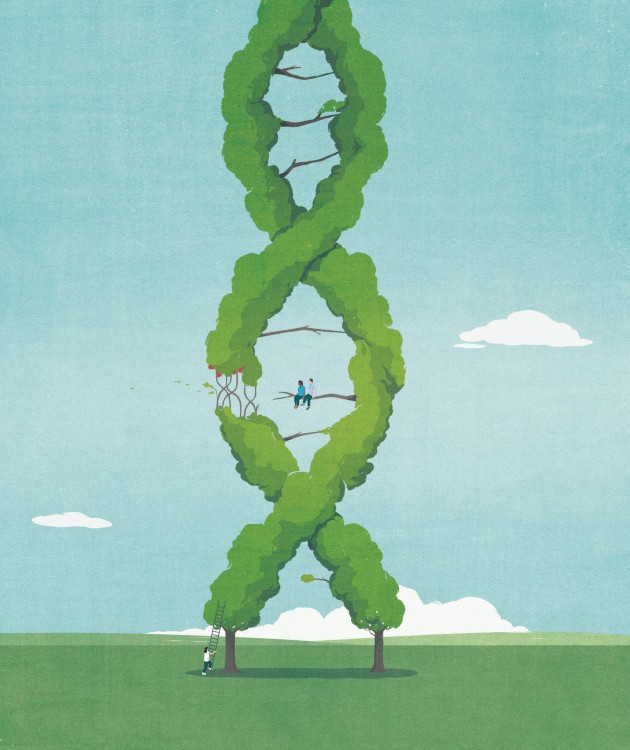Genomics is the study of the whole genome, which comprises all the genetic information of an individual. This information can help to support diagnosis of a health condition, predict the likelihood of developing a condition in later life, and inform treatment pathways.
It’s increasingly becoming part of mainstream care, and Tracie Miles, Associate Director of Nursing and Midwifery at the NHS South West Genomic Medicine Service Alliance, encourages all nursing staff to know the basics.
The ‘Jolie’ gene
Many people’s first introduction to genomics was when actress Angelina Jolie went public about an inherited mutation in her BRCA gene in 2013.
The BRCA gene is a tumour suppressor gene, responsible for repairing DNA. A mutation, change or alteration in this gene makes the patient more at risk of certain cancers, such as in the breasts, ovaries and fallopian tubes, and a patient with a BRCA mutation might go on to have risk-reducing surgery.
“Angelina’s story raised considerable awareness of genomics,” says Tracie, who was a gynae cancer specialist nurse at the time.
Following the news, Tracie soon saw many ovarian cancer patients asking her about the ‘Jolie’ gene. That’s when she decided to improve her knowledge of genomics to offer better patient-centred care.
Mainstreaming services
There are seven regional genomic medicine service alliances in England, each aligned with seven genomic laboratory hubs – where the genetic tests are carried out. Each of the devolved nations have their own genomic testing network.
Their goal is to roll out genomic testing within secondary care, as part of a treatment pathway, reducing the need to refer patients to a separate clinical genetics service.
It can help with cancer surveillance, predict diabetes, and reduce risks of future health issues
“This could take place in oncology, cardiac, even respiratory units – anywhere genetics might play a substantial role in a patient’s health outcome,” says Tracie.
“This new pathway is an example of mainstreaming, but it requires more and more staff to be trained and educated in genomics."
Genomics in practice
Tracie is trained to discuss genetic testing with patients and their families – this is what she calls counselling and consenting.
“Many nursing staff think they haven’t got time to train, haven’t got time to counsel and consent patients, haven’t got time to learn,” says Tracie. “But there are so many clinical reasons to encourage genomics education.”
There are many different conditions and syndromes linked to cancer risk that testing can spot.
Lynch syndrome, like BRCA, carries a higher risk of colorectal and endometrial (womb) cancers.
“We know that womb cancer is often the signal cancer in Lynch syndrome,” says Tracie. “We might be able to successfully treat a patient for their womb cancer, but if we don’t offer testing for Lynch, we could miss the opportunity to spot another cancer early, and the patient could be back in hospital requiring more complex intervention.”

More than cancer
“Nursing staff might think genomics is a job for genetic counsellors, and they might feel intimidated by the subject if they don’t know much about it.
“But genomics can play a role in so many areas. Respiratory nurses, for example, don’t need to know about gynaecological or cardiac genomics, but they should know about genomics in their field and signpost patients accordingly.
“We don’t have to become experts, but genomics has moved from niche to necessity. We are seeing an element of genomics in so many care pathways.”
The COVID-19 pandemic has also highlighted the important role genomics plays.
“The language we hear on the news is about genomics – things like variants, for example – has made the general public familiar with the concept of genetic mutations. We developed the COVID-19 vaccine because we understand how DNA works. We are generation genome.
“Our patients are more savvy and more able to hear the genomic message, so now is the time for more nursing staff to get on board.”
Genomic literacy
Genomic literacy means having a level of competence and confidence to talk about genetics.
“Family histories can be complicated, but nursing staff are already listening to family histories every time they meet a patient,” Tracie says.
“They’re at their bedside, in their home, or preparing them for surgery, and patients will already be telling staff about themselves, their health, and their loved one’s health. They’ve already started taking a rudimentary family history.”
Genomic testing can be a gift to families
For example, a nursing assistant might be talking to a patient on a cancer ward. The patient might mention they have cancer in the family.
In this instance, that nursing assistant’s genomic literacy might simply be understanding that the patient is talking about genomics and recognising that they might not be able to help them any further.
They can respond: I understand you want to talk more about your family history, and you might be thinking there’s a genetic link. This is not my field of expertise, but I can introduce you to another health professional who can take the conversation on further.
Beyond one patient
“Genomic testing can be a gift to families,” says Tracie. “It allows you to future-proof family health to a certain extent.
“It can help with cancer surveillance, predict diabetes, and it allows us to reduce risks of cancer. We’re not just testing the patient, we’re testing their wider family.”
If testing picks up an inherited change, then the family can be offered predictive testing to see if they too carry an alteration or mutation.
“This gives the family members the option to understand the implications of predictive testing,” Tracie explains.
Illustrations by Andrea Ucini
Useful resources
- Health Education England runs a Genomics Education Programme to help health professionals make best use of genomics in their practice.
- Genomics sits within the RCN’s Public Health Forum.








